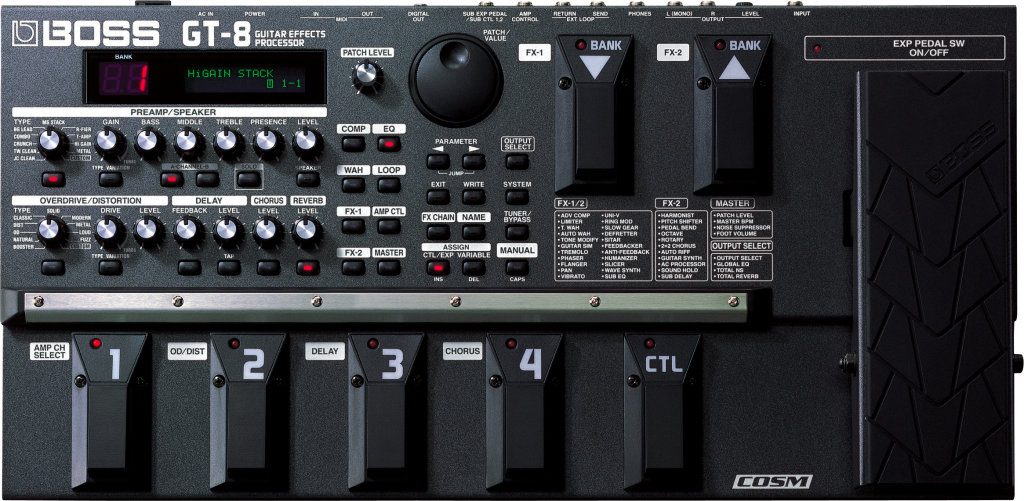[Editor’s note – read last month’s issue or head here to catch up on part one, in which we discuss tremolo, vibrato, chorus, flange and more.]
PHASING
Often confused with the previous chorus and flange, this can be attributed to the way these effects are created, but the differences are noticeable when you know what to listen for. A phaser splits the signal in two, sending one part through an all-pass filter, then into an LFO and finally recombines it with the original sound. An all-pass filter passes all frequencies through without attenuation, but inverts the phase of various frequencies. All of this gadgetry creates a sweeping movement to the recorded track it’s applied to. We love the use of this effect on the guitars in the Tame Impala song “Solitude is Bliss.” Phasers are great for when you want you guitar tracks to have an ethereal quality like that track.
RING MODULATION
Now we’re getting into the really crazy stuff! There is certainly no confusing a ring modulation effect. If you want to take a track you just recorded and make it sound like the most terrifying nightmare you could image, ring modulation is the tool for you. To get technical, ring modulation mixes the frequencies of two waveforms and outputs the sum and difference of the frequencies present in each waveform. What is created from this is a variety of sounds, ranging from screeching shrill tones to ominous bell-like sounds. Because of this effect’s unorthodox sound, it is not as commonly used in popular music but one of the best examples of this effect being used on a guitar track would Tony Iommi’s solo in the quintessential Black Sabbath song “Paranoid.” If you listen closely with headphones, you can hear in one ear the unaffected guitar signal and in the other ear you can hear the distorted ring-modulated version of the solo. By using this effect, the guitar solo is given an extra crunch and heaviness that is really effective.
ROTARY EFFECTS
How could we forget the classic Leslie speaker sound that is recreated by the rotary effect? The Leslie speaker is a combined amplifier and loudspeaker that modifies the sound of an instrument as well as amplifying it, by rotating the sound waves. As the sound source is rotated around a specific pivot point, it produces both a tremolo effect and a variation in pitch (so in a certain sense we are combining the tremolo and vibrato effects). The Leslie was made originally in a single speed but was later upgraded to dual speed. There are now a number of effect pedals and software plug-ins we can use to achieve this sound without having an actual Leslie set up. This effect has been used to great effect in a number of classic songs, including George Harrison’s rhythm guitar track in the chorus of “Lucy in the Sky with Diamonds” and the haunting guitar arpeggios in the verses of Soundgarden’s “Black Hole Sun.” The rotary effect works great when you are going for a more psychedelic “swirly” sound, as you could probably gather from the examples above.
WAH WAH EFFECTS
I think we all know a lead guitarist who loves to bust out his Cry Baby pedal and shred ‘til the cows come home (whether or not your song needs the solo). Though wah wah may not completely fit into the modulation effect category, it works in some similar ways and we feel it’s worth a mention. The wah wah effect alters the tone of the guitar signal to create a distinctive effect, mimicking the human voice. As you move the pedal up and down, the signal emphasizes a particular frequency, which creates that classic sound. This effect has been used by many lead guitarists, but probably the most iconic would be the one and only Jimi Hendrix. This effect is demonstrated in the classic opening riff of “Voodoo Child (Slight Return).”
IN SUMMATION
There are quite a few modulation effects at your disposal, all of which are pretty easy to access as most recording software comes with built in plug-ins that recreate these effects. As with most things in the studio, there are no right or wrong answers when it comes to adding effects in the mix. We tend to feel that “less is more” in most instances, but feel free to experiment with different sounds and modulations if your budget (and time) permits. Now that you know the differences between these different effects, listen for them in your favorite artists’ songs. Identify how they use them and make note of the times when you really like the way an effect is being used. I know that here at Night Train Studios, we love it when a band or solo artist can come in and give us a reference track and point out a specific guitar tone/modulation effect that they want us to emulate. This takes a lot of the guesswork out of the mixing and tracking processes. Plus, having a general knowledge of modulation effects will make it much easier to communicate what you are looking for to your engineer/producer if you do not have a specific reference song or to be able to recreate these sweet sounds in your own home studios.
ABOUT THE AUTHORS
Zac Cataldo is a musician and owner/producer at Night Train Studios, a recording studio in Westford, MA. He is also co-owner of Black Cloud Productions, a music publishing company. Reach him at zac at nighttrainstudios.com.
Brent Godin is a bassist/guitarist and engineer/producer at Night Train Studios. He is also a talent scout at Black Cloud Productions. Reach him at brent at blackcloudproductions.com.
